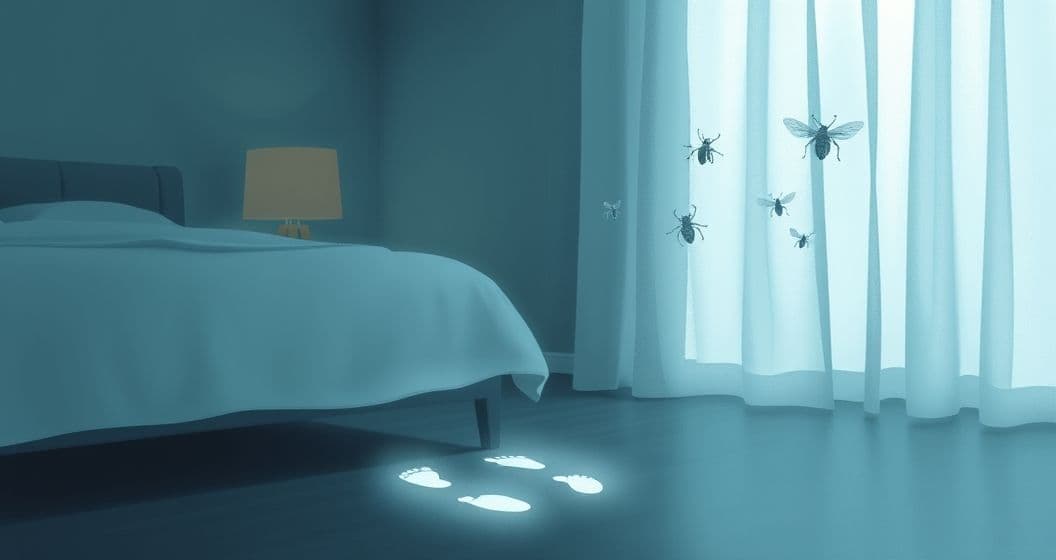Core Symbols: The Bugs, Footprints, and Bedroom Chambers
Bugs in dreams rarely represent literal insects; instead, they often embody small, persistent concerns that feel inescapable. In the context of bed footprints, these bugs take on a tracking quality—they leave trails that you’re compelled to follow, suggesting an inability to ignore nagging issues. The 'bed chambers' themselves are deeply symbolic: the bedroom is your most intimate sanctuary, so invading it with bugs and footprints speaks to a violation of safety, comfort, or personal boundaries. Imagine a spider crawling across your pillow, leaving a silvery trail; the unease isn’t just about the spider—it’s about the space it’s claimed as its own, mirroring how small, unaddressed problems can feel like they’re colonizing your life.
Footprints add another layer of meaning: they’re evidence of movement, continuity, and inevitability. Unlike a random bug, a trail implies purpose—something is following you, or something you’ve ignored is now following you back. If the footprints lead directly into your bedroom, this suggests the source of your anxiety is deeply personal, rooted in spaces where you should feel most secure. Cultural traditions sometimes view footprints as markers of destiny or unfinished business; in dreams, they become a visual reminder that some things refuse to stay buried.
Psychology Lens: Unpacking the Subconscious Journey
Want a More Personalized Interpretation?
Get your own AI-powered dream analysis tailored specifically to your dream
🔮Try Dream Analysis FreeFrom a Jungian perspective, bugs might represent shadow aspects of yourself—parts of your personality you’ve repressed but that now feel 'invading' your awareness. The act of following them into the bedroom could signify confronting these hidden traits rather than avoiding them. Freud, meanwhile, might interpret the bed as a symbol of repressed desires, and the bugs as manifestations of anxieties about unfulfilled needs or forbidden impulses. The footprints, in this view, become the path to understanding these repressed feelings.
Neuroscience offers another angle: during REM sleep, the brain processes emotional memories, and the amygdala (which handles fear responses) remains active. If you’ve experienced stress or uncertainty in waking life—even subtle, daily pressures—the brain might translate these into the visceral imagery of bugs and trails. Think of it as your mind’s way of 'replaying' unresolved emotions: the bugs are the emotional residue, and the footprints are the narrative thread connecting past stress to present unease.
Life Triggers: What’s 'Bugging' You in Waking Life?
These dreams often surface during periods of transition or vulnerability. Moving to a new home, starting a relationship, or facing overwhelming responsibilities can create a sense of instability, which the subconscious translates into the 'invasion' of bugs. If you’ve been avoiding a conversation, ignoring a messy project, or letting small resentments build, the bed—your space of rest—becomes a metaphorical battlefield where these issues 'attack.'
Consider a scenario: you’ve been procrastinating on a work deadline, and each day feels like a bug leaving a trail of stress behind. As the deadline approaches, your mind might project this anxiety into a dream where bugs follow you into your bedroom, the final 'safe' space, because the subconscious recognizes that even rest isn’t immune to unaddressed stress. The bedroom chambers, once a refuge, now feel compromised—a reflection of how modern life blurs the lines between work, rest, and personal boundaries.
What To Do Next: Reclaiming Your 'Bug-Free' Space
Start with short-term reflection: Journal the details of your dream. Note the type of bugs, the direction of the footprints, and how the bedroom chambers appeared (cluttered, dark, open?). Ask yourself: What feels 'buggy' in my life right now? This could be a recurring task, a relationship dynamic, or even self-doubt. Writing it down externalizes the 'invader,' making it easier to address.
For medium-term action, create small 'rituals of safety' in your bedroom. This might mean decluttering, adding plants that repel pests (metaphorically, if not literally), or setting a physical boundary like a nightlight to reclaim the space. Address one small 'bug' at a time—whether it’s a pending call, a messy desk, or a habit you’ve been avoiding. By taking these tiny steps, you’ll disrupt the 'footprint' pattern and rebuild trust in your personal space.
Long-term, integrate practices that strengthen your boundaries. This could involve mindfulness meditation to recognize when stress is 'invading' your peace, or setting clear work hours to protect your rest time. Remember: the goal isn’t to eliminate all 'bugs'—which is impossible—but to create a space where you can coexist with them without feeling overwhelmed. Like a gardener tending to weeds, you’re learning to distinguish between harmful infestations and manageable challenges.
FAQ
Q: What if the bugs in my dream are not bed bugs but other insects?
A: Different insects carry nuanced meanings—ants might signal overwhelming responsibilities, while spiders could represent creative blockages. However, the core theme remains: small, persistent concerns tracking into your private life. Focus on the emotion the insects evoked, not their species.
Q: Is this dream a sign of an actual infestation?
A: Dreams rarely predict literal events, but they often reflect underlying anxiety about order or safety. If you’re genuinely concerned about pests, address it practically; otherwise, use the dream as a signal to tidy up emotional 'messiness' in your life.
Q: Why do the footprints feel so significant?
A: Footprints represent continuity—they show a path you’ve taken (or avoided) and the consequences of that path. Following them in dreams urges you to notice patterns in how you respond to stress, helping you break cycles of avoidance.
